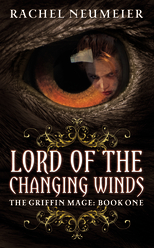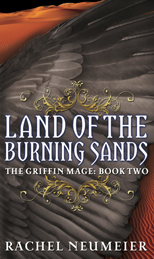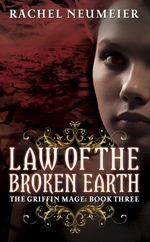Why Griffins?

Look, I don’t have anything against dragons. Honest. Dragons appear in two of my own books (not out yet). I love dragons! Especially the ones in RA MacAvoy’s Tea with the Black Dragon and Naomi Novik’s Temeraire and Barbara Hambly’s Dragonsbane. Maybe my favorite dragon of all time appears in Patricia McKillip’s The Cygnet and the Firebird, which right there probably tells you that I especially like my dragons to be powerful, subtle, ancient and wise.
But I’ve always had a soft spot for griffins. Lo these many years ago, I found a nice bit of griffin artwork at an SF convention art show. If you glance at it quick, all you see is ordinary hawks feeding their nestlings. But take a closer look and it’s a wilderness scene that clearly didn’t come out of National Geographic. I appreciate this artist’s conception of griffins – but I didn’t want my griffins to be just wild animals.
I thoroughly enjoyed the griffins in Diana Wynn Jones’ Year of the Griffin. Those griffins are people: just like anyone, really, except for the little detail of being half eagle and half lion. Those griffins call a human mage “Dad”, and mean it. They’re wonderful, but I didn’t want my griffins to be just ordinary people, either.

The griffin I actually had in mind when I first thought of including griffins in a book was the one in Nick O’Donohue’s The Magic and the Healing. I wanted my griffins to be more or less like that one, which only goes to show what firm intentions will get you. Which is to say, nothing. Because my griffins are nothing at all like O’Donohue’s wonderful Griffin, Asturiel. Asturiel is on the savage side of noble and the rigid side of just and he’s a fantastic character, but though my griffins are admittedly a touch savage, they went off in an entirely different direction.
What happened was, I wrote the first couple of paragraphs of Lord of the Changing Winds, and those paragraphs came out more or less this way:
The griffins came to Feierabiand with the early summer warmth, riding the wind out of the heights down to the tender pastures of the foothills. The wind they brought with them was a hard hot wind, with nothing of the gentle Feierabiand summer about it. It tasted of red dust and hot brass.
Kes . . . saw them come: great bronze wings shining in the sun, tawny pelts like molten gold, sunlight striking harshly off beaks and talons. One was a hard shining white, one red as the coals at the heart of a fire. The griffins rode their wind like soaring eagles, wings outstretched and still. The sky took on a fierce metallic tone as they passed. They turned around the shoulder of the mountain and disappeared, one and then another and another, until they had all passed out of sight. Behind them, the sky softened slowly to its accustomed gentle blue.
Well, that was unexpected. I honestly no idea I was going to make griffins into creatures of fire until, check it out, there they are bringing a desert with them into the ordinary countryside. Who knew?
But I liked the idea at once and not only kept it, but ran with it. Right away it was obvious that if griffins were going to be creatures of fire, this could set them up as different from ordinary human people, who I immediately decided were creatures of earth. And if griffins were going to be different from humans, I decided I’d make them different – different not only physically and in the magic they use, but also psychologically. Though I hope readers will enjoy my griffins, and sympathize with them, and more or less kind of understand them, my griffins aren’t human – and from that difference arises the underlying conflict that drives the whole griffin trilogy.

Could I have used dragons instead of griffins? Sure. But everybody who reads fantasy has already got a favorite dragon, isn’t that right? Or at the very least a clear picture of what a proper dragon ought to be like, whether a dangerous monster or basically a regular person or a wonderful plot device. We already know plenty about dragons.
But griffins don’t come with such firmly attached images or associations. I don’t know whether griffins might possibly be the next big thing after dragons finally begin to pall – probably not, but who knows? – but I do know that a writer can have fun taking a less well-known mythological creature off in a direction even she finds totally unexpected. And I hope my readers have fun with that, too!
